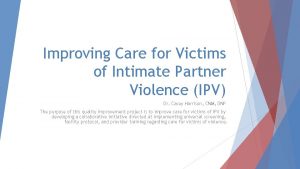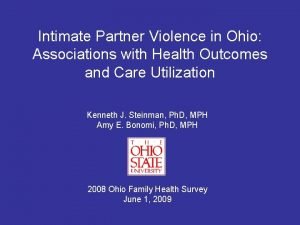Intimate Partner Violence Health Care Utilization and Insurance









![IPV prevalence n Weighted % 95%CI 351 1. 9 [1. 6 -2. 2] 18 IPV prevalence n Weighted % 95%CI 351 1. 9 [1. 6 -2. 2] 18](https://slidetodoc.com/presentation_image_h2/7c0d4dd7b09ce6095412381b0dff30e4/image-10.jpg)








- Slides: 18

Intimate Partner Violence, Health Care Utilization and Insurance Status: Results from a Large Population-Based survey Kenneth J. Steinman, Ph. D, MPH Amy E. Bonomi, Ph. D, MPH Academy on Violence & Abuse April 25, 2009 Supported by a grant from the Ohio Family Health Survey

Background • IPV (intimate partner violence) is associated with HCU (health care utilization) (Coker et al. , 2004; Helweg-Larsen, 2003; Rivara et al, 2007) • Few population-based studies • Little consideration of insurance status

Goals • Assess IPV-HCU association in a population-based sample • Does association vary by insurance status?

Ohio Family Health Survey • • • September 2008 -January 2009 n=50, 944 (23, 083 women <65) Computer-Assisted Telephone Interviews Random Digit Dialing Over-sampling of ethnic minorities, select counties • Representative of Ohio adults & households • Response rate: 47%

Dependent Variables • During the past 12 months, how many times were you a patient in… – an urgent care center? – a hospital emergency room? – a hospital overnight?

IPV measure • During the past 12 months, how many times, if any, has anyone hit, slapped, pushed, kicked or physically hurt you? • Think about the time of the most recent incident involving a person or persons who hit, slapped, pushed, kicked or physically hurt you. What was that person’s relationship to you? (open-ended)

classifying a case of intimate partner violence How many times…? 0 times Not a case 1+ times What was that person’s relationship to you? 04 Male/Female first date 05 Someone you were dating 06 Former boyfriend/girlfriend 07 Current boyfriend/girlfriend or fiancé 08 Spouse or live-in partner 09 Former spouse or live-in partner intimate partner violence 01 Stranger 02 Coworker 03 Professional caretaker 10 S/he is my Child 11 S/he is my Stepchild 12 Another family member 13 Acquaintance/friend 97 OTHER 98 DK 99 REFUSED Other violence

Other Variables • Age, ethnicity, region • Socioeconomic status – Income, education, home ownership • Insurance status – Uninsured; Medicaid; Employer-based; Other

Data Analysis • Bivariate association – Covariates with IPV – IPV with dependent variables • Generalized Linear Model – Poisson distribution, log link – Controlling for age, ethnicity, SES • Weighted data; complex survey design
![IPV prevalence n Weighted 95CI 351 1 9 1 6 2 2 18 IPV prevalence n Weighted % 95%CI 351 1. 9 [1. 6 -2. 2] 18](https://slidetodoc.com/presentation_image_h2/7c0d4dd7b09ce6095412381b0dff30e4/image-10.jpg)
IPV prevalence n Weighted % 95%CI 351 1. 9 [1. 6 -2. 2] 18 -24 75 5. 3 [4. 0 -6. 9] 25 -34 93 2. 1 [1. 5 -2. 8] 35 -44 85 1. 8 [1. 3 -2. 5] 45 -54 72 1. 1 [0. 8 -1. 5] 55 -64 26 0. 4 [0. 2 -0. 8] white 259 1. 7 [1. 4 -2. 1] black 70 3. 3 [2. 4 -4. 5] Hispanic 22 2. 7 [1. 5 -4. 7] Asian 0 --* Total Age Race/Ethnicity

IPV prevalence (2) n Weighted % 95%CI <100% 145 4. 3 [3. 4 -5. 5] 100 -300% 133 2. 1 [1. 7 -2. 7] >300% 73 0. 8 [0. 5 -1. 1] owns home 173 1. 3 [1. 6 -2. 2] does not own home 176 3. 5 [2. 8 -4. 3] Income as % of federal poverty level Home ownership

IPV prevalence (3) n Weighted % 95%CI < High school 44 3. 8 [3. 4 -5. 5] High school graduate 259 1. 3 [1. 7 -2. 7] College Graduate 48 0. 2 [0. 5 -1. 1] Education

IPV prevalence (4) n Weighted % 95%CI Insurance type Medicaid 127 5. 2 [4. 1 -6. 7] employer-based 105 0. 7 [0. 5 -0. 9] uninsured 83 4. 5 [3. 4 -6. 0] Other a 36 1. 8 [1. 1 -2. 9] a Other insurance types include: Medicare only, directly purchased, unknown

Association of IPV with Health Care Utilization: a Prevalence Ratio (unadjusted) 95% CI Prevalence Ratio (adjusted)a 95% CI Urgent care 2. 1 [1. 7 -2. 7] 1. 6 [1. 3 -2. 1] Emergency room 2. 2 [1. 9 -2. 6] 1. 5 [1. 3 -1. 7] Hospital Admission 1. 7 [1. 3 -2. 2] 1. 3 [1. 0 -1. 7] Adjusted for age, ethnicity, income, education, home ownership, insurance status

Association of IPV with Hospital Admission: Variation by Insurance Status Uninsured Medicare Employer. Based (n=2, 924) (n=2, 998) (n=13, 763) Other (n=2, 395) PRR 95% CI Urgent care 2. 3 [1. 5 -3. 5] 1. 4 [1. 0 -1. 9] 1. 3 [0. 8 -2. 4] 1. 9 [1. 0 -3. 7] Emergency room 1. 7 [1. 3 -2. 3] 1. 4 [1. 1 -1. 7] 1. 4 [0. 9 -2. 2] 1. 9 [1. 1 -3. 2] Hospital admission 1. 2 [0. 6 -2. 4] 1. 1 [0. 8 -1. 6] 1. 1 [0. 6 -2. 0] 3. 0 [1. 7 -5. 2] PRR=Prevalence Ratio (adjusted for age, ethnicity, income, education, home ownership)

Discussion • IPV – HCU association holds in general population • IPV prevalence varies by insurance status • IPV – HCU association may vary by insurance status – Smaller effects for among women with employer-based insurance (EBI)?

Implications • Urgent care may be important source of care • EBI samples may underestimate IPV-HCU association • Include insurance as a component of SES • Useful alternative measurement approach

Thank you
 Periwinkle doerfler
Periwinkle doerfler Health and social care component 3 health and wellbeing
Health and social care component 3 health and wellbeing Unit 2 equality diversity and rights
Unit 2 equality diversity and rights Define the relationship chapter 15
Define the relationship chapter 15 Define the relationship ch 7
Define the relationship ch 7 Define the relationship chap 7
Define the relationship chap 7 Levels of health care primary secondary tertiary
Levels of health care primary secondary tertiary Functions of fire insurance
Functions of fire insurance Intimate distance example
Intimate distance example Intimate family chapter 6
Intimate family chapter 6 Intimate family chapter 6
Intimate family chapter 6 Intimate family chapter 2
Intimate family chapter 2 Intimate family chapter 2
Intimate family chapter 2 Consultative register example
Consultative register example Dewgarden foaming intimate wash benefits
Dewgarden foaming intimate wash benefits Intimate zone in communication
Intimate zone in communication Intimate zone in communication
Intimate zone in communication Scary antonym
Scary antonym 01 me line intimate
01 me line intimate



































